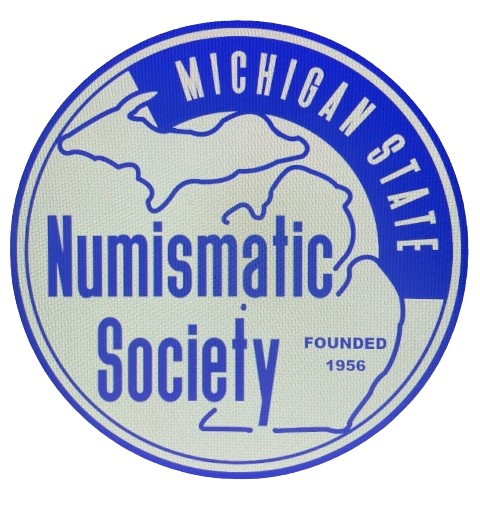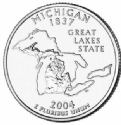Numis-stability by Daniel Sheffer (MichMatist, Fall 2009)
A question often asked by beginning collectors is “What is it worth?” It seems that many collectors today care more about what their collections are worth than the history or beauty the coins, tokens, or notes possess. Many collectors have come to expect that their collection should increase in value at a steady pace. And those collectors that buy silver and gold coins get excited when their latest purchase increases in value within a week. This is very sad. Collecting is supposed to be a hobby, not an investment like stocks or bonds. On the other hand if every item you bought went down in value that would not be good either. What I suggest is the collector look for items that possess numis-stability.
This is a term I coined (pun intended) to describe a numismatic item that is not likely to drop substantially in value. But the item is not likely to increase in value quickly either. Rather the coin, token, or note may stay at the same price for say 5 years, and then increase by 10% for example. Remember, numismatics is a long term pursuit. Also you are supposed to use disposable income to make purchases, not the rent money.
Numis-stability can be practiced with any collecting budget. Before I give some examples, let me remind you that what you collect does not have to be expensive. Many collectors and dealers have this false view that if the coin or note does not cost $50 or $100 it is “not worth collecting”! Nothing could be further from the truth. In 1917 my great grandfather Ernest Hack was selling uncirculated 1909-S, V.D.B. cents for 25 cents each. Would these have been a bad investment? No! Today those coins would sell for over $1,500. And I’m sure there are coins that are inexpensive today, which will be worth multiples of their current value in a few decades. Collect what you enjoy.
Okay, now let’s look at some examples that possess numis-stability. I will start with lower priced items and work my way up.
The first coin that comes to mind is the 1996-W Roosevelt dime. The “W” Mintmark stands for West Point Mint, located in New York. There were only 1,457,000 made. This is a low mintage, especially for a modern coin. 1996 was the 50th anniversary of the Roosevelt dime. To commemorate this milestone, the government decided to mint this special-issue dime. And all of the coins were included in Mint sets! None of the “W” dimes were placed into circulation, at least not by the Mint. But sometimes people inherit coin collections, and not knowing any better spend the coins from Mint sets. So watch your change. The 1996 Mint set currently retails for about $13 to $15. But on its’ own, a nice 1996-W dime sells for $15 to $20! The dime comes in its’ own cellophane sleeve, inside the envelope. When purchasing a 1996 Mint set, make sure the dime is still with the set. If you are lucky enough to buy a few sets I think you will have a good candidate for a coin with Numis-stability.
Going up a level, a collector with say $50 to $100 to spend should consider Civil War tokens featuring Abraham Lincoln. I wrote about these historic tokens in the spring 2009 issue of MichMatist . Lincoln collectables have increased in popularity in the past few years with the arrival of Lincolns 200th birthday in February 2009. These tokens have been avidly collected for 145 years, and show no signs of loosing popularity. The two tokens I suggest for the average collector are Fuld numbers 127/248 and 128/289b. Both tokens show a bearded Lincoln. The depictions however are quite different from the current Lincoln cent (1909-present). As I suggested my previous article, these tokens make a nice companion to your Lincoln cent collection. Collectors of Civil War tokens are encouraged to join the Civil War token Society. This wonderful organization has a quarterly journal. The Journal is filled with interesting stories about tokens and the men and (yes!) women that issued them.
If coins or tokens do not interest you, consider paper money. For around $200 you can find some really rare and under-valued notes. Many collectors collect notes from their home town or state. You could collect obsolete notes (1800-1866) or National Bank notes (1865- 1929). If you have been considering the paper money field, now is a good time to start. Paper money values have taken a breather from their upward march from the mid 1990’s to about mid 2008. This means it’s a buyers market. There are quite a few rare-note-issuing towns in Michigan. I suggest you buy and study MICHIGAN PAPER MONEY: OBSOLETE, SCRIP AND NATIONAL NOTES by Michigan native Dr. Wallace Lee. Lee gives a brief history of the town, the bank, and the rarity of the notes. Collectors of paper money are encouraged to join the Paper Money Collectors of Michigan (PMCM). This wonderful organization also issues a quarterly journal filled with interesting stories about all forms of paper money. PMCM meets in Dearborn at the spring and fall conventions.
If you have deep pockets, you might consider rarer date gold coins. You don’t have to be a coin collector to know gold has been a popular item lately. There are hundreds of companies wanting to buy your scrap gold. But collectors are buying gold coins to form a collection. The demand for gold has pushed premiums very high for common date gold coins. If gold prices settle down in the future, the values of these common date coins will drop as well. Not to worry, you can collect gold coins that had slightly lower mintages, which only cost slightly more than their common cousins, but will retain more of their value if gold prices come down. An example of a gold coin with Numis-stability is the 1872-S eagle ($10 gold piece). With a mintage of just 17,300 the 1872-S can’t be too common. Looking in A GUIDE BOOK OF UNTITED STATES COINS (popularly known as the Red Book) 2010 edition, we see that in VF (very fine grade) the 1872-S is listed at $625. A common date such as 1907, mintage 1.2 million, is listed at $575 in the same VF grade. Not bad for an extra $50. There is one other factor when purchasing gold coins. That is melting of the gold coins over the last 100+ years. A coin with a high mintage could actually be rare, or a low mintage coin could have survived in large numbers. This is why you will want to study the series you are interested in before making purchases.
There are many options in all fields of numismatics to find items with Numis-stability. You will have to research your area of interest to figure out which coins have held their value, and don’t have large increases or decreases in price over the past few decades. It’s very simple. The information you need is readily available online, and in books or magazines. Use these resources for an enhanced collecting experience.









